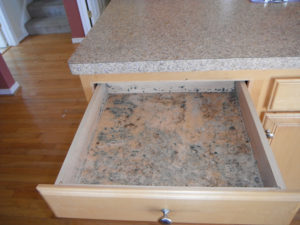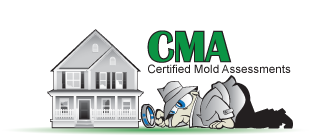 Imagine finding a mold on the ceiling of your shower stall. On closer inspection, you find it on the walls as well. It’s growing in the grout between tiles, and it’s even making headway on the shower floor. Eager to take care of the problem, you hit the mold with bleach, cleaning fluids, and rigorous scrubbing. By the time you’re finished, everything looks nice and clean, with not a trace of mold anywhere.
Imagine finding a mold on the ceiling of your shower stall. On closer inspection, you find it on the walls as well. It’s growing in the grout between tiles, and it’s even making headway on the shower floor. Eager to take care of the problem, you hit the mold with bleach, cleaning fluids, and rigorous scrubbing. By the time you’re finished, everything looks nice and clean, with not a trace of mold anywhere.
You breathe a sight of relief, knowing the nasty problem has been taken care of. But has it? You may have done a decent job cleaning up the visible mold in your bathroom — but that doesn’t mean the problem is solved. The reality is, visible mold is usually just the tip of the iceberg. Wherever you’ve seen visible mold — especially when it has recurred multiple times, despite having been cleaned up — there’s likely to be invisible mold growing behind the walls, under the floorboards, and even possibly in the ductwork.
Mold is a very clever customer. It has a knack for growing and thriving in places where no one ever looks. Places where it can slowly gain ground without being disturbed.
Underlying conditions
The most common “missing link” in most serious mold remediation cases is proper mold testing, professional remediation, and solid mold prevention strategies. A minor mold problem doesn’t become extremely serious overnight — but if weeks, months and years pass without any real mold remediation efforts (for instance, if you continue scrubbing away visible mold without considering what’s going on behind the walls), mold can become a very serious problem indeed. That’s when you may find yourself in need of a costly, full-scale mold remediation protocol.
On top of that, many states and local jurisdictions require full reporting on mold remediation history. That means if your home has ever undergone mold remediation, potential buyers will have to be informed. The mold “stigma” is well-documented in the world of real estate, and it’s definitely best to avoid the necessity for major cleanup operations. This is done by recognizing and correcting the underlying conditions responsible for mold — and correcting them before the problem gets out of hand.
Humidity, lack of ventilation, leakage from broken pipes, flooding, aging materials, and lack of proper lighting are all examples of conditions that cause or exacerbate mold problems. You might need a minor mold remediation operation, followed by solid professional advice on how to prevent the recurrence of mold — but this will not affect your home’s marketability like a full-scale cleanup operation will. Plus (and most importantly), it keeps you and your family healthy by preventing acute mold exposure and the associated health risks.
Finding a mold expert you can trust
You certainly don’t want mold growing in your home, but you also don’t want to fall victim to a disreputable mold remediation company who makes the problem sound much worse than it is. The only type of mold specialist that deserves your business is a reputable one who gives you straight answers, provides accurate testing, and only recommends mold remediation when necessary.

